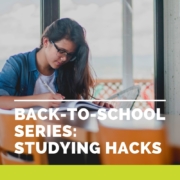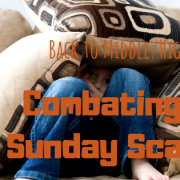For me, the Sunday scaries began about a week ago, when it became suddenly undeniable that my summer was coming to an abrupt end. Painful as this realization was, I can only imagine it to be even more so unpleasant for my students. Yes, I’m a teacher. And yes, my Sunday night scaries can still be just as brutal as the impending doom that accompanied my Sunday evenings throughout adolescence. Almost 20 years has passed since my own bouts with middle school anxiousness were at an all-time high, and yet, Sunday scaries can still summon that familiar sense of impending doom. So what is a high schooler (or high school teacher) to do when the scaries rear their ugly heads? Asking for a friend…
Stop saying “I’ll do it Sunday”
Quite possibly (and most logically), the reason that Sunday scaries are even a thing is due to the fact that adults and adolescents alike choose to postpone or procrastinate during the weekend. For many of us, Sundays are reserved for cleaning, laundering, meal prepping, etc. High schoolers do the same thing—they put off any homework, projects, or essays until Sunday evening. Teens put school work off until the last minute because it is the last possible thing they would like to do during their weekend reprieve.
While this makes perfectly logical sense, teens only compound their stress further and muster up Sunday scaries when they choose to save every task for Sunday night. Furthermore, in putting off these tasks, whether it be school work or chores, the item to be completed becomes that much more dreaded purely because of our previous avoidance. Instead, encourage teens to complete at least part of a large assignment or homework item early on in the weekend.
This small modification removes the daunting task of simply sitting down and starting. For many, starting an assignment or essay is the most difficult aspect, and thus, the most avoided. Tackling something headon removes the anxiety associated with the very beginning of the task. In chunking an assignment or essay over the weekend, teens also help themselves with their time management, maintaining focus and attention, and prioritizing the most difficult aspects of the assignment, as opposed to all-out cramming in one sitting.
Double check for necessary items beforehand
Again, saving things for the last minute (Sunday night) only allows room for more unforeseeable obstacles and less time to circumvent those obstacles. If middle and high schoolers know that a permission form, essay, or application is due in the early part of the week, Sunday night is NOT the time to realize that they are missing a key component of that form, essay, application, etc. Checking for these essential items during the course of the weekend leaves time for any unexpected emergency to be taken care of so that Sunday scaries are kept at bay.
Mark my words: Sunday night is when all printers run out of ink, or paper, or jam, or malfunction, or spontaneously explode. And you better believe that anywhere from two to ten other students will have the same printer “catastrophe” that prohibits them from submitting their essay on Monday morning. High schoolers can avoid this panic attack and their teacher’s subsequent eye-roll by printing ahead of time—it’s much easier to find an open Staples or Office Depot on Saturday afternoon than after 10pm on Sunday.
Know your priorities and work accordingly
Organizing tasks appropriately throughout the weekend allows students to identify and prioritize a to-do list. As natural procrastinators can tell you, teens would much prefer to do the easy or fun tasks first. However, this is of no help to them. Parents should encourage teens to get into the habit of completing the more difficult or high-stakes items first.
Yes, it may be more enticing to come up with a cheer for the pep rally, but the history research paper should come first. Help middle and high schoolers prioritize their lists by using the “fun” tasks as rewards for completing the difficult items first.
Look ahead
Using a small amount of time on Sunday night to look at the week ahead can help to alleviate the Sunday scaries as well. Often times, stress of the unknown or last-minute surprises are what create anxiety for teens. By sitting down and perusing the week’s calendar, families can ensure that a) everyone is on the same page about appointments/events, b) there are no surprises or last-minute to-dos, and c) events and tasks are evenly spaced as to not overbook any member of the family. A combined calendar in a central location also helps to correct the “I didn’t know” or “I forgot” excuse. If everyone is on the same page about the upcoming week, goals are sure to be met.












